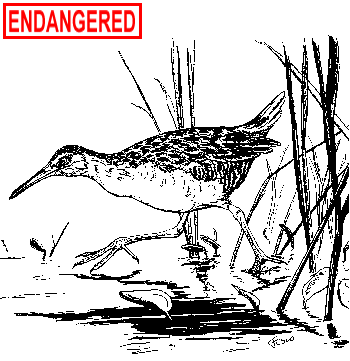King Rail
Rallus elegans

Habitat: Freshwater marshes and brackish tidal marshes.
Weight: 10-18 ounces.
Length: 15-19 inches.
Wingspan: 21-25 inches.
Life Expectancy: 5-9 years of age.
Food: Crustaceans, fish fry, amphibians, insects and many seeds of weeds and aquatic plants.
Status: State endangered (nesting populations).
Identification: The king rail is the largest North American rail, with an appearance similar to that of the more common clapper rail, whose habitat is generally restricted to saltwater marshes. The slightly larger king rail has a more brownish appearance than the grayish clapper rail. Also, the barring on the flanks of the king rail shows greater definition, and the king rail has a more red-brown breast. Sexes are similar, but the male is slightly larger.
Range: The king rail nests locally in freshwater wetland habitats from the Atlantic coast west to the Great Plains. Southern New England is the northern extreme of its eastern range. The species winters along the coast from Connecticut south to the Gulf of Mexico.
Reproduction: King rails are known to return to the same nesting area year after year. The nest is in a grass-lined depression on the ground or slightly elevated in the branches of wetland shrubs such as buttonbush. Ground nests are often concealed by green grasses arched over the nest. The 8 to 11 eggs are pale buff, spotted with browns. Territories are established in a similar fashion to songbirds. Both sexes participate in nest building, incubation and care of the downy, precocial young. Both adults incubate the eggs for about 22 days. The young leave the nest shortly after hatching and make their first flight in about 63 days.
Reason for Decline: The king rail is still common across its entire range. However, degradation and loss of freshwater marsh habitats have resulted in a decline of localized populations.
History in Connecticut: Historically, the king rail was never common in Connecticut. The first nesting by king rails in the state was reported in the early 1840s along the coast. The species has been considered a rare nester ever since. The king rail may nest in well-concealed locations on large, inland freshwater marshes, but nests have not been documented in these areas.
Interesting Facts: The king rail has been known to hybridize with the clapper rail.
King rails regurgitate indigestible parts of their food in pellets similar to those of owls. During courtship, males present crayfish or small fiddler crabs in their bill to females, who readily accept the offered morsels.
The king rail's preference for freshwater marshes has led to two other common names, marsh hen and freshwater marsh hen.
The call of the king rail is often likened to the sound of a rider or teamster clucking to horses. Illinois farmers nicknamed the bird "stage driver" after this "chuck-chuck" call.
The day-old, downy young have vestigial claws at the carpal joints of their wings.
Protective Legislation: Federal - Migratory Bird Treaty Act of 1918; federal migratory game bird hunting regulations. State - Connecticut General Statutes Sec. 26-311; migratory game bird statutes, Connecticut General Statutes Sec. 26-91.
What You Can Do: Loss of freshwater and brackish water marsh habitats is the greatest threat to Connecticut's nesting king rails. Encourage the protection, conservation and reclamation of Connecticut's marshland habitats.

The production of this Endangered and Threatened Species Fact Sheet
Series is made possible by donations to the Endangered Species/Wildlife Income Tax
Checkoff Fund.
(rev. 12/99)

